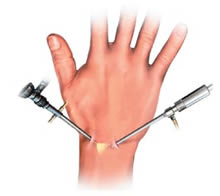Wrist arthroscopy is surgery that uses a tiny camera and surgical tools to examine or repair the tissues inside or around your wrist. The camera is called an Arthroscope. The procedure allows the doctor to detect problems and make repairs to the wrist without making larger cuts in the skin and tissue. This means that you may have less pain and recover more quickly.
Description
You will likely receive general anesthesia before this surgery. This means you will be asleep and unable to feel pain. Or, you may have regional anesthesia. Your arm and wrist area will be numbed so that you do not feel any pain. If you receive regional anesthesia, you will also be given medicine to make you very sleepy during the operation.
During the procedure, the surgeon does the following:
- Inserts the Arthroscope into your wrist through a small incision. The scope is connected to a video monitor in the operating room. This allows the surgeon to view the inside of your wrist.
- Inspects all the tissues of your wrist. These tissues include cartilage, bones, tendons, and ligaments.
- Repairs any damaged tissues. To do this, your surgeon makes 1 to 3 more small incisions and inserts other instruments through them. A tear in a muscle, tendon, or cartilage is fixed. Any damaged tissue is removed.
At the end of the surgery, the incisions will be closed with stitches and covered with a dressing (bandage). Most surgeons take pictures from the video monitor during the procedure to show you what they found and what repairs they made.
Your surgeon may need to do open surgery if there is a lot of damage. Open surgery means you will have a large incision so that the surgeon can get directly to your bones and tissues.
Why the Procedure Is Done
You might need wrist arthroscopy if you have one of these problems:
- Wrist Pain: Arthroscopy allows the surgeon to explore what is causing your wrist pain.
- Ganglion Removal: This is a small, fluid-filled sac that grows from the wrist joint. It is harmless, but it can be painful and can limit your ability to move your wrist freely.
- Ligament Tears: A ligament is a band of tissue that connects bone to bone. Several ligaments in the wrist help keep it stable and allow it to move. Torn ligaments can be repaired with this type of surgery.
- Carpal Tunnel Release: Carpal tunnel syndrome occurs when the nerve that passes through certain bones and tissues in your wrist becomes swollen and irritated. With arthroscopy the area through which this nerve passes can be made larger to relieve the pressure and pain.
- Wrist Fractures: Arthroscopy can be used to remove small bits of bone and realign the bones in your wrist.
Before the Procedure
Tell your health care provider what medicines you are taking. This includes medicines, supplements, or herbs you bought without a prescription.
During the 2 weeks before your surgery:
- You may be asked to stop taking medicines that make it harder for your blood to clot. These include aspirin, ibuprofen (Advil, Motrin), naproxen (Naprosyn, Aleve), and other medicines.
- Ask your health care provider which medicines you should still take on the day of your surgery.
- If you have diabetes, heart disease, or other medical conditions, your surgeon will ask you to see your doctor who treats you for these conditions.
- Tell your health care provider if you have been drinking a lot of alcohol, more than 1 or 2 drinks a day.
- If you smoke, try to stop. Ask your health care provider or nurse for help. Smoking can slow wound and bone healing.
- Tell your doctor about any cold, flu, fever, herpes breakout, or other illness you may have before your surgery.
On the day of surgery:
- You will likely be asked not to drink or eat anything for 6 to 12 hours before the procedure.
- Take the medicines your health care provider told you to take with a small sip of water.
- Your health care provider will tell you when to arrive at the hospital. Be sure to arrive on time.
After the Procedure
- You can go home the same day after spending an hour or so in recovery. You should have someone drive you home.
- Keep your wrist elevated above your heart for two to three days to help reduce swelling and pain. You can also apply a cold pack to help with swelling.
- Keep your bandage clean and dry. Your health care provider can show you how to change the dressing.
- You can take pain relievers, if needed, as long as your doctor says it’s safe to do so.
Outlook (Prognosis)
Arthroscopy uses small cuts in the skin, so compared to regular surgery, you may have:
- Less pain and stiffness
- Fewer complications
- Faster recovery
The small cuts will heal quickly and you may be able to resume your normal activities in a few days. However, if your doctor had to repair a lot of tissue in your wrist, it may take several weeks to heal.
You may be shown how to do gentle exercises with your fingers and hand. Your doctor may also recommend that you see a physical therapist to help you regain the full use of your wrist.


